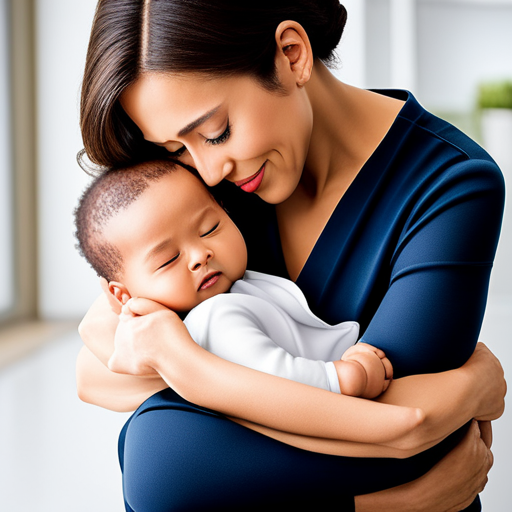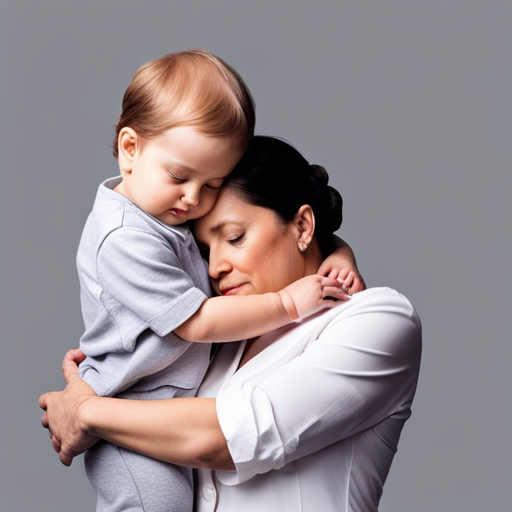"Cherishing Little Steps - A Haven for Baby and Family Journeys"
Burping Sleeping Baby
Do you ever find yourself in the middle of the night, desperately trying to burp your peacefully sleeping baby? You gently lift them up, hoping to release the trapped air and provide them with comfort.
Burping a sleeping baby can be a challenging task, but it is essential for their well-being. In this guide, we will explore various techniques and strategies to help you effectively burp your little one without disturbing their precious slumber.
From finding the right positioning to utilizing burping aids, we will provide you with the knowledge and tips to navigate this nighttime ritual with ease.
So, let’s dive in and discover the secrets to burping your sleeping baby like a pro!
Key Takeaways
- Burping releases trapped air in the baby’s stomach and helps prevent discomfort and excessive gas.
- There are various burping techniques such as the shoulder hold, lap hold, face-down on lap, football hold, sitting position technique, over-the-leg hold technique, and upright hold technique.
- Gentle patting and rubbing stimulates baby’s back muscles and encourages burping.
- Utilizing burping aids and finding what works best for your baby can provide maximum comfort and relief.
Importance of Burping

Why is burping your sleeping baby important?
Burping your baby isn’t just a routine task; it actually has several benefits for their digestion. When babies drink milk, they tend to swallow air along with it. This air can build up in their tiny stomachs and cause discomfort, leading to fussiness and even colic. By burping your baby, you can help release this trapped air, relieving any discomfort and preventing excessive gas.
There are a few techniques you can try to burp a reluctant baby. One common method is to hold your baby upright against your shoulder and gently pat or rub their back. Another technique is to sit your baby on your lap, supporting their chin with one hand while using the other hand to pat their back. Some babies may respond well to a gentle rocking motion while being held in an upright position.
It is important to keep in mind that every baby is different, and what works for one may not work for another. Be patient and experiment with different techniques until you find the one that works best for your baby.
Positioning Techniques

To burp your sleeping baby, try using different positioning techniques. Finding the right position can help facilitate burping and provide comfort to your little one. Here are some optimal positioning techniques you can try:
-
The Shoulder Hold: Place your baby against your shoulder, supporting their head and neck with your hand. Gently pat or rub their back in an upward motion to encourage burping.
-
The Lap Hold: Sit on a chair or couch and position your baby on your lap, facing outward. Support their chest and head with one hand while using the other to pat or rub their back.
-
The Face-Down on Lap: Lay your baby face-down across your lap, with their chin resting on your thigh. Use gentle pressure on their back or pat in an upward motion to help release any trapped air.
-
The Football Hold: Position your baby along your forearm, with their head supported by your hand. Their body should rest along your side, facing upward. Use your other hand to pat or rub their back.
Gentle Patting and Rubbing

To effectively burp your sleeping baby, gently pat and rub their back. This technique helps to release any trapped air and promote digestion, providing relief for your little one. The gentle patting and rubbing motion stimulates the baby’s back muscles, encouraging them to burp. It also has a soothing effect, creating a sense of comfort and security for your baby.
Here is a simple table that outlines the steps for gentle patting and rubbing:
| Steps | Description |
|---|---|
| Position your baby | Place your baby on your shoulder or lap, ensuring their head is supported and neck is straight. |
| Cup your hand | Gently cup your hand and use the heel of your hand to pat your baby’s back. |
| Rub in circular motion | Using the pads of your fingers, rub your baby’s back in a circular motion. |
| Adjust pressure and speed | Experiment with different pressures and speeds to find what is most comfortable for your baby. |
Remember to be gentle and responsive to your baby’s cues. If they become uncomfortable or agitated, try different techniques or take a break and try again later. Your touch and presence are soothing to your baby, so enjoy this intimate bonding moment while helping them find relief.
Utilizing Burping Aids

To utilize burping aids, try incorporating specialized devices or techniques to help release trapped air from your sleeping baby. Here are some effective ways to make the burping process easier and more efficient:
-
Burping techniques: Experiment with different techniques to find what works best for your baby. Some popular techniques include the over-the-shoulder method, sitting your baby upright on your lap, or gently rocking them back and forth while supporting their chin.
-
Burping frequency: It’s important to burp your baby regularly during feeding sessions, especially if they’re bottle-fed or if they tend to swallow air while breastfeeding. Aim to burp your baby every 2-3 ounces if bottle-feeding, or after each breast during breastfeeding.
-
Burping aids: Consider using specialized burping aids such as burp cloths, burping cushions, or burping pads to provide extra support and comfort for your baby during the burping process. These aids can help keep your baby in an upright position and prevent any discomfort or reflux.
-
White noise machines: Using a white noise machine can help soothe your baby and create a calming environment, making it easier for them to relax and release trapped air during burping.
Burping During Night Feeds

Burp your baby during night feeds to prevent discomfort and promote better sleep. Nighttime feeding can be a challenging time for both you and your little one. It’s important to minimize any disruptions to their sleep, as well as your own. By burping your baby during night feeds, you can help alleviate any gas or discomfort they may be experiencing, allowing them to settle back into sleep more easily.
During nighttime feeding, it’s essential to create a calm and soothing environment. Keep the lights dim and the room quiet, so as not to stimulate your baby too much. After a feed, gently hold your baby against your shoulder, supporting their head and neck. Use gentle patting or rubbing motions on their back to encourage them to burp. It may take a few minutes for them to release any trapped air, so be patient.
To help you keep track of your baby’s nighttime feeding and burping routine, you can use the following table:
| Night Feed Time | Duration of Feed | Burping Technique |
|---|---|---|
| 1:00 am | 20 minutes | Patting |
| 3:30 am | 15 minutes | Rubbing |
| 5:45 am | 25 minutes | Patting |
Troubleshooting Common Challenges

One common challenge when burping a sleeping baby is finding the right position that will effectively release trapped air. It can be frustrating when your little one is peacefully snoozing, but you know that there’s gas building up inside them. Luckily, there are a few techniques you can try to overcome this challenge:
-
The Shoulder Hold: Gently place your baby’s chin on your shoulder and support their bottom with your hand. Pat their back in a rhythmic motion to help release the trapped air.
-
The Sitting Position: Sit your baby on your lap, facing away from you. Use one hand to support their chest and head while the other hand pats their back. This position can be especially helpful for babies who’ve difficulty burping in other positions.
-
The Over-the-Leg Hold: Lay your baby face-down across your lap, with their tummy resting on one of your legs. Gently pat their back to encourage burping.
-
The Upright Hold: Sit your baby upright on your lap with their head supported by your hand. Gently rub or pat their back in an upward motion to help release trapped air.
Remember, every baby is different, so don’t be discouraged if one position doesn’t work for your little one. Keep experimenting until you find the position that helps them release the trapped air.
Happy burping!
Frequently Asked Questions
Can Burping a Baby Help Reduce Colic Symptoms?
Burping your baby can be a helpful technique to reduce colic symptoms. It’s a natural remedy that can provide relief. By gently patting or rubbing their back, you can release gas and ease discomfort.
What Are Some Alternative Positioning Techniques for Burping a Baby?
To burp your baby, you can try alternative positions like side lying or sitting up. These positions can help release trapped air and reduce colic symptoms. It’s important to find what works best for your little one.
Are There Any Specific Burping Aids That Are Recommended for Newborns?
There are specific burping aids that can be beneficial for newborns. These aids can help you burp your baby more effectively, ensuring they remain comfortable and free from gas or discomfort.
Should I Burp My Baby During Every Night Feed?
You absolutely should burp your baby during every night feed! It helps prevent discomfort and gas, promoting better sleep for both of you. Try different burping techniques for breastfed babies to find what works best.
How Can I Tell if My Baby Is Not Burping Properly and Experiencing Discomfort?
If your baby is not burping properly, they may show signs of discomfort such as fussiness, bloating, or pulling their legs up. To soothe them, try gently massaging their tummy or putting them in a warm bath.
Conclusion
In conclusion, ensuring that your little one is properly burped is crucial for their comfort and well-being. By employing various positioning techniques and gentle patting and rubbing, you can help ease any discomfort caused by trapped air.
Don’t hesitate to utilize burping aids if needed, and remember to burp your baby during night feeds to promote uninterrupted sleep. If you encounter any challenges, rest assured that with a little troubleshooting, you’ll find the best method that works for you and your precious baby.
Happy burping!


